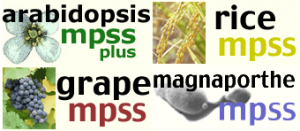Status:
Platform:
Species:
A class of eukaryotic non-coding RNAs termed microRNAs (miRNAs) interact with target mRNAs by sequence complementarity to regulate their expression. The low abundance of some miRNAs and their time- and tissue-specific expression patterns make experimental miRNA identification difficult. We present here a computational method for genome-wide prediction of Arabidopsis thaliana microRNAs and their target mRNAs. This method uses characteristic features of known plant miRNAs as criteria to search for miRNAs conserved between Arabidopsis and Oryza sativa. Extensive sequence complementarity between miRNAs and their target mRNAs is used to predict miRNA-regulated Arabidopsis transcripts.
Our prediction covered 63% of known Arabidopsis miRNAs and identified 83 new miRNAs. Evidence for the expression of 25 predicted miRNAs came from northern blots, their presence in the Arabidopsis Small RNA Project database, and massively parallel signature sequencing (MPSS) data. Putative targets functionally conserved between Arabidopsis and O. sativa were identified for most newly identified miRNAs. Independent microarray data showed that the expression levels of some mRNA targets anti-correlated with the accumulation pattern of their corresponding regulatory miRNAs. The cleavage of three target mRNAs by miRNA binding was validated in 5' RACE experiments.
We identified new plant miRNAs conserved between Arabidopsis and O. sativa and report a wide range of transcripts as potential miRNA targets. Because MPSS data are generated from polyadenylated RNA molecules, our results suggest that at least some miRNA precursors are polyadenylated at certain stages. The broad range of putative miRNA targets indicates that miRNAs participate in the regulation of a variety of biological processes.[1]
MPSS (massively parallel signature sequencing) is a sequencing-based technology that uses a unique method to quantify gene expression level, generating millions of short sequence tags per library. We have created a series of databases for four species (Arabidopsis, rice, grape and Magnaporthe grisea, the rice blast fungus). Our MPSS databases measure the expression level of most genes under defined conditions and provide information about potentially novel transcripts (antisense transcripts, alternative splice isoforms and regulatory intergenic transcripts). A modified version of MPSS has been used to perform deep profiling of small RNAs from Arabidopsis, and we have recently adapted our database to display these data. Interpretation of the small RNA MPSS data is facilitated by the inclusion of extensive repeat data in our genome viewer. All the data and the tools introduced in this article are available at http://mpss.udel.edu.[2]
Identification of all expressed transcripts in a sequenced genome is essential both for genome analysis and for realization of the goals of systems biology. We used the transcriptional profiling technology called 'massively parallel signature sequencing' to develop a comprehensive expression atlas of rice (Oryza sativa cv Nipponbare). We sequenced 46,971,553 mRNA transcripts from 22 libraries, and 2,953,855 small RNAs from 3 libraries. The data demonstrate widespread transcription throughout the genome, including sense expression of at least 25,500 annotated genes and antisense expression of nearly 9,000 annotated genes. An additional set of approximately 15,000 mRNA signatures mapped to unannotated genomic regions. The majority of the small RNA data represented lower abundance short interfering RNAs that match repetitive sequences, intergenic regions and genes. Among these, numerous clusters of highly regulated small RNAs were readily observed. We developed a genome browser (http://mpss.udel.edu/rice) for public access to the transcriptional profiling data for this important crop.[3]
Massively parallel signature sequencing (MPSS) is a technology capable of sequencing simultaneously almost all the DNA molecules in a sample. This technology is well suited for deep profiling of mRNA and small RNA by the sequencing of cDNA tags. A series of mRNA MPSS databases has been created from various libraries derived from four different species (Arabidopsis, rice, grape, and Magnaporthe grisea, the rice blast fungus). Our mRNA MPSS databases measure the absolute expression level of most genes in the sample and provide information about potentially novel transcripts (antisense transcripts, alternative splice isoforms, and regulatory intergenic transcripts). In addition to these data, we have recently built an extensive database from MPSS-derived Arabidopsis small RNA samples. All the databases are accessible thorough our Web interface (http://mpss.udel.edu), and the individual pages are equipped with various graphical and analytical tools. Here, we focus on a subset of these tools (e.g., Gene Analysis [GA], Chromosome Viewer [CV], and Library Analysis [LIBAN]) and describe how the users can analyze and interpret our MPSS expression data.[4]
References
- Prediction and identification of Arabidopsis thaliana microRNAs and their mRNA targets.,
, Genome Biol, 2004, Volume 5, Issue 9, p.R65, (2004)
- Plant MPSS databases: signature-based transcriptional resources for analyses of mRNA and small RNA.,
, Nucleic Acids Res, 2006 Jan 1, Volume 34, Issue Database issue, p.D731-5, (2006)
- An expression atlas of rice mRNAs and small RNAs.,
, Nat Biotechnol, 2007 Apr, Volume 25, Issue 4, p.473-7, (2007)
- Methods for analysis of gene expression in plants using MPSS.,
, Methods Mol Biol, 2007, Volume 406, p.387-408, (2007)








